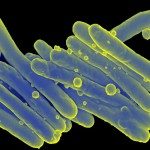Link to Pubmed [PMID] – 29216510
Curr. Opin. Microbiol. 2017 Dec;41:68-75
Interactive link to publication (via Share link):
https://authors.elsevier.com/a/1WARP4tPFpD~Sy
Abstract
Mycobacterium tuberculosis, the causative agent of human tuberculosis is one of the most widely spread human pathogens. It has succeeded to infect a quarter of the global human population by developing most sophisticated ways to circumvent innate and adaptive immune defences. This highly specialized, major human pathogen has evolved from a pool of ancestral environmental mycobacteria, whose extant representatives are known under the name of Mycobacterium canettii. Recent whole genome analyses in combination with different phenotypic screens have provided key insights into the evolution of M. tuberculosis and closely related members regrouped in the M. tuberculosis complex (MTBC). They have also elucidated novel virulence determinants that are essential for these obligate pathogens. In this review, we present the most recent evolutionary models of the MTBC and various factors that have contributed to the outstanding evolutionary success of the tuberculosis agent.


